Adrian Collins's Blog, page 175
May 16, 2021
REVIEW: Norylska Groans by Michael R. Fletcher and Clayton W. Snyder
Grimdark steampunk Russian influenced fantasy set within an industrial city in a Russian flavored fantasy world with mob families competing over magical memory stones? I’m in! Norylska Groans is a fine fantasy collaboration between Snyder and Fletcher, mixing these great story elements together and creating a story that’s unique.
“The city moaned, the creak of shrinking wood. Off to the north the furnaces rumbled like sleeping dragons. Never silent. Noryslka groans.”
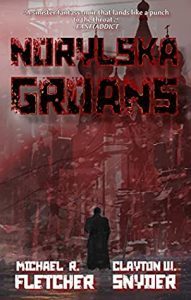 Norylska Groans is told through the perspectives of two characters, with the chapters alternating between their views. Genndy Antonov is an ex-soldier, struggling to acclimate to life after his military service, becoming disgruntled with the feeling that he’s been discarded by the system he served. He’s currently making ends meet with his heavily taxed pension and his current job as a cutter in a butchery. He has a pregnant wife at home and is just getting by when he is suddenly laid off.
Norylska Groans is told through the perspectives of two characters, with the chapters alternating between their views. Genndy Antonov is an ex-soldier, struggling to acclimate to life after his military service, becoming disgruntled with the feeling that he’s been discarded by the system he served. He’s currently making ends meet with his heavily taxed pension and his current job as a cutter in a butchery. He has a pregnant wife at home and is just getting by when he is suddenly laid off.
Katyushka Leonova is a young woman that had grown up with money, but her family had fallen on hard times with her father’s disgrace. She is engaged to an up-and-coming young attorney, but he’s not there yet so she’s taking on extra secretarial work with the militsiya, which is Norylska’s police force. Kat soon learns that she has “volunteered” for a new program within the militsiya to bring women into active military duty.
The cold is almost a character itself in this story. Ever a concern, all facets of life have to be planned with the bone chilling deadly cold and wind in mind.
“The wind cut through his coat like teeth of ice as he trod the streets, however, so he forgave the vodka its trespass in exchange for false warmth.”
Gen is approached by Arkady, a member of the Shkut crime family, just after being laid off. He is promised work and good pay, which Gen is in no position to refuse if he wants to keep his family warm and fed.
Kat is partnered with Maks, an old veteran of the militsiya, to investigate the Filth, a neighborhood of Norylska that is rougher and more dangerous than the average, as it’s controlled by the Shkut family. She is equipped with memory stones, which are imbued with the experiences she’ll need to be an effective member of the militsiya. These stones also contain personality traits that she’ll have to give her the bravery and determination necessary to get the job done.
Memory stones are at the heart of this story, as they are valuable and powerful. It is while using these stones that Kat discovers some dark secrets about the militsiya and her partner, including the disturbing realization that they contain the memories of Maks’s former partner, who was tortured and killed by the Shkut.
“Digging was slow in the permafrost, but still the men made good time. The earth may have been frozen, but these men were colder.”
As one can imagine, there are surprises and twists and turns all through the story. The city of Norylska casts a gloomy (and cold) shadow over everything, setting the tension at a high level throughout. I’m not sure if this is a standalone novel or the first in a series, but it works either way. Norlyska Groans is an exciting read and a good way to spend a few evenings, but you might want to make sure you have plenty of blankets to keep you warm, and maybe a good bit of vodka as well.
Read Norylska Groans by Michael R. Fletcher and Clayton W. Snyder
The post REVIEW: Norylska Groans by Michael R. Fletcher and Clayton W. Snyder appeared first on Grimdark Magazine.
Norylska Groans by Michael R. Fletcher and Clayton W. Snyder
Grimdark steampunk Russian influenced fantasy set within an industrial city in a Russian flavored fantasy world with mob families competing over magical memory stones? I’m in! Norylska Groans is a fine fantasy collaboration between Snyder and Fletcher, mixing these great story elements together and creating a story that’s unique.
“The city moaned, the creak of shrinking wood. Off to the north the furnaces rumbled like sleeping dragons. Never silent. Noryslka groans.”
 Norylska Groans is told through the perspectives of two characters, with the chapters alternating between their views. Genndy Antonov is an ex-soldier, struggling to acclimate to life after his military service, becoming disgruntled with the feeling that he’s been discarded by the system he served. He’s currently making ends meet with his heavily taxed pension and his current job as a cutter in a butchery. He has a pregnant wife at home and is just getting by when he is suddenly laid off.
Norylska Groans is told through the perspectives of two characters, with the chapters alternating between their views. Genndy Antonov is an ex-soldier, struggling to acclimate to life after his military service, becoming disgruntled with the feeling that he’s been discarded by the system he served. He’s currently making ends meet with his heavily taxed pension and his current job as a cutter in a butchery. He has a pregnant wife at home and is just getting by when he is suddenly laid off.
Katyushka Leonova is a young woman that had grown up with money, but her family had fallen on hard times with her father’s disgrace. She is engaged to an up-and-coming young attorney, but he’s not there yet so she’s taking on extra secretarial work with the militsiya, which is Norylska’s police force. Kat soon learns that she has “volunteered” for a new program within the militsiya to bring women into active military duty.
The cold is almost a character itself in this story. Ever a concern, all facets of life have to be planned with the bone chilling deadly cold and wind in mind.
“The wind cut through his coat like teeth of ice as he trod the streets, however, so he forgave the vodka its trespass in exchange for false warmth.”
Gen is approached by Arkady, a member of the Shkut crime family, just after being laid off. He is promised work and good pay, which Gen is in no position to refuse if he wants to keep his family warm and fed.
Kat is partnered with Maks, an old veteran of the militsiya, to investigate the Filth, a neighborhood of Norylska that is rougher and more dangerous than the average, as it’s controlled by the Shkut family. She is equipped with memory stones, which are imbued with the experiences she’ll need to be an effective member of the militsiya. These stones also contain personality traits that she’ll have to give her the bravery and determination necessary to get the job done.
Memory stones are at the heart of this story, as they are valuable and powerful. It is while using these stones that Kat discovers some dark secrets about the militsiya and her partner, including the disturbing realization that they contain the memories of Maks’s former partner, who was tortured and killed by the Shkut.
“Digging was slow in the permafrost, but still the men made good time. The earth may have been frozen, but these men were colder.”
As one can imagine, there are surprises and twists and turns all through the story. The city of Norylska casts a gloomy (and cold) shadow over everything, setting the tension at a high level throughout. I’m not sure if this is a standalone novel or the first in a series, but it works either way. Norlyska Groans is an exciting read and a good way to spend a few evenings, but you might want to make sure you have plenty of blankets to keep you warm, and maybe a good bit of vodka as well.
Read Norylska Groans by Michael R. Fletcher and Clayton W. Snyder
The post Norylska Groans by Michael R. Fletcher and Clayton W. Snyder appeared first on Grimdark Magazine.
May 15, 2021
REVIEW: Theft of Swords by Michael J. Sullivan
Reading Michael J. Sullivan’s Theft of Swords is the most I’ve enjoyed the first entry in a fantasy series for a long time. In fact, it contains two stories from The Riyria Revelations: The Crown Conspiracy and Avempartha. These were originally released individually by Sullivan on a self-published basis and were combined into this excellent package by Orbit in 2011. To readers new to Sullivan’s work, Theft of Swords and The Riyria Revelations is what the author recommends reading first. The Riyria Chronicles are prelude adventures that follow the same two protagonists. I’m noting the above details as I read 25% of this novel before realising that I was reading the books in the suggested order. Read here for more information about Michael J. Sullivan’s recommended reading order.
 Theft of Swords follows the adventures of Riyria. Riyria is made up of two legendary and infamous rogues who take on seemingly impossible heists and requests, normally for nobles who can afford their services to “embarrass a rival, to hurt an ex-lover, or to increase their standing in the strange and twisted world of high-stakes politics.” The duo aren’t affiliated with any guilds, monarchs, or political factions, so can tread where other thieves would be unable to operate, with their unique and tailored set of skills. Hadrian Blackwater is a charismatic and genuinely good-natured warrior who carries three swords. Trust me, a man who carries three swords knows how to use them. His partner is Royce Melborn, an extremely talented thief who is a master of stealth and comfortable walking in the shadows. He is much more cynical and critical than his colleague and he holds his cards close to his chest. I enjoyed having certain mysteries around Royce unravel gradually as I read on.
Theft of Swords follows the adventures of Riyria. Riyria is made up of two legendary and infamous rogues who take on seemingly impossible heists and requests, normally for nobles who can afford their services to “embarrass a rival, to hurt an ex-lover, or to increase their standing in the strange and twisted world of high-stakes politics.” The duo aren’t affiliated with any guilds, monarchs, or political factions, so can tread where other thieves would be unable to operate, with their unique and tailored set of skills. Hadrian Blackwater is a charismatic and genuinely good-natured warrior who carries three swords. Trust me, a man who carries three swords knows how to use them. His partner is Royce Melborn, an extremely talented thief who is a master of stealth and comfortable walking in the shadows. He is much more cynical and critical than his colleague and he holds his cards close to his chest. I enjoyed having certain mysteries around Royce unravel gradually as I read on.
“Two hundred gold tenents to slip a sword out an open window—you don’t find that suspicious?” Royce asked with a tone of amazed disbelief.
Theft of Swords has an excellent opening segment, with a gang of amateur thieves choosing the wrong marks, which then leads into one of my favourite fantasy adventure story setups. I was truly excited at the 10% mark and was completely invested in the duo’s exploits and the possibilities that could present themselves in the novel.
“Hadrian shook his head and sighed. “Why do you have to make everything so difficult? They’re probably not bad people—just poor. You know, taking what they need to buy a loaf of bread to feed their family. Can you begrudge them that? Winter is coming and times are hard.” He nodded his head in the direction of the thieves. “Right?”
“I ain’t got no family,” flat-nose replied. “I spend most of my coin on drink.”
“You’re not helping,” Hadrian said.”
 The Crown Conspiracy and Avempartha take place chronologically in a familiar-feeling but distinct enough fantasy world that is large in scope and features gods, histories, and political maneuverings. The Crown Conspiracy had elements of mystery surrounding who killed a main character and uncertain motives of key players. The mystery elements were well-worked and there are many puzzles and secrets in Sullivan’s world that I am sure will be revealed the further the series progresses but I’m fascinated to find out more about the Dwarves and the Elves. Tropes they may be, yet I’m intrigued to see how they’ll fit in Sullivan’s stories. The world-building throughout is neatly done, although, during the first story, there is a fair bit of info-dumping by the extremely likeable priest, Myron Lanaklin. He has a convenient photographic memory. Slightly different in tone with some more grim and sombre content, Avempartha was slightly reminiscent of a Sapkowski The Witcher short story with a dragon-like Gilarabrwyn harassing a small farming town.
The Crown Conspiracy and Avempartha take place chronologically in a familiar-feeling but distinct enough fantasy world that is large in scope and features gods, histories, and political maneuverings. The Crown Conspiracy had elements of mystery surrounding who killed a main character and uncertain motives of key players. The mystery elements were well-worked and there are many puzzles and secrets in Sullivan’s world that I am sure will be revealed the further the series progresses but I’m fascinated to find out more about the Dwarves and the Elves. Tropes they may be, yet I’m intrigued to see how they’ll fit in Sullivan’s stories. The world-building throughout is neatly done, although, during the first story, there is a fair bit of info-dumping by the extremely likeable priest, Myron Lanaklin. He has a convenient photographic memory. Slightly different in tone with some more grim and sombre content, Avempartha was slightly reminiscent of a Sapkowski The Witcher short story with a dragon-like Gilarabrwyn harassing a small farming town.
In addition to Royce and Hadrian, the other two main characters are Prince Alric and Princess Arista. Throughout certain sections in these two tales, their lives intertwine with the thieves’ missions. The fact Sullivan made me adore Riyria so aptly and promptly, I was probably unfair on the Alric and Arista sections, rushing them to begin with to get back to the thieves’ escapades. As the stories progressed though, and these characters became more fleshed out, I liked their moments too, however, when reflecting, the majority of the standout moments did feature Hadrian and Royce. As happened with the brother and sister, I believe it will be the same result with the rest of the side characters and that as they get more page time, I’ll become more invested with them as they become more three-dimensional too. There are some fine creations already though including Esrahaddon and Thrace.
“Royce stared out at the tower in the middle of the river and considered why jobs involving stealing swords were never simple.”
I’m glad that I finally decided to give Sullivan’s catalogue another go. I tried Age of Myth about two years ago and something about it didn’t work for me at the time. After reading Theft of Swords and knowing his popularity and fanbase, I would class Sullivan as a heavyweight of the current fantasy author scene. To Grimdark Magazine readers who have come across this review, I will gladly recommend Theft of Swords. The novel features hope, heart, and humour, especially delivered through Hadrian, which nicely colours in the turmoil, grittiness, and political uncertainty of Sullivan’s world. An extremely addictive read that I raced through and enjoyed thoroughly. I don’t doubt that I will adore Rise of Empire at least equally. (Minor spoiler in the below quotation.)
Read Theft of Swords by Michael J. Sullivan“So,” Royce said, “you want us to escape from this prison, kidnap the king, cross the countryside with him in tow while dodging soldiers who I assume might not accept our side of the story, and go to another secret prison so that he can visit an inmate?”
Arista did not appear amused. “Either that, or you can be tortured to death in four hours.”
“Sounds like a really good plan to me,” Hadrian declared.“Royce?”
“I like any plan where I don’t die a horrible death.”
The post REVIEW: Theft of Swords by Michael J. Sullivan appeared first on Grimdark Magazine.
May 14, 2021
REVIEW: Watchmen
Watchmen is an nine-episode adaptation of Alan Moore and Dave Gibbons’ genre-defining graphic novel that was once viewed as being impossible to adapt for tv or film. Following on from the story finished in the comic and the film (directed by Justice League’s Zack Snyder), Watchmen proves that there is a lot of excitement and joy to be found in the dark, odd world created by Moore and Gibbons.
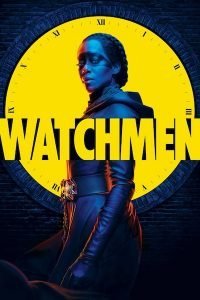 Watchmen is a TV series that does not play things safe. The 2009 film delivered a comic book adaption that mainly stuck to the path set out by Moore and Gibbons but it received mixed reviews (though there has been an increased interest in the film over the recent years). Watchmen as a TV series carves its own path with writer Damon Lindelof (Lost, The Leftovers) choosing to show the events following the interesting ending of the original graphic novel. Extra dimensional squid fall from the sky as Angela Abar attempts to solve the murder of the chief of police.
Watchmen is a TV series that does not play things safe. The 2009 film delivered a comic book adaption that mainly stuck to the path set out by Moore and Gibbons but it received mixed reviews (though there has been an increased interest in the film over the recent years). Watchmen as a TV series carves its own path with writer Damon Lindelof (Lost, The Leftovers) choosing to show the events following the interesting ending of the original graphic novel. Extra dimensional squid fall from the sky as Angela Abar attempts to solve the murder of the chief of police.
Fans of the comic and the Moore and Gibbons’ comic and Snyder’s film will be comforted by the familiarity of returning Watchmen characters such as Adrian Veidt (played with scene-stealing quality by Jeremy Irons) and moments that nod to scenes in the comic are there to flesh out the world and not just act as fan service. But Watchmen does so much more than play to the fans. It is a show that takes risks and plays with real-world issues prevalent today. Just as the original comic was able to be groundbreaking and inspire so many artists and writers in and out of the superhero genre, the TV show is able to break new ground and touch on real-world issues without seeming too preachy or condescending. Skipping between a 1921 massacre, the original 1980’s timeline of the comics, and the modern day, Watchmen delivers a show that feels fresh and relevant as it dissects the historical barriers that are placed between people that must be knocked down for the world to progress and it touches on issues that America have at times preferred to ignore and keep hidden in the shadows. Re-watching the show, it is plain to see that some of the issues regarding the police and race within the show are as relevant today as they have ever been and Watchmen delivers such commentary with a deft hand that guides the viewer without seeming too preachy.
The cinematography is spot on and the use of colour and camera angles are of a quality that is rarely seen on the small screen. It is a pleasure to watch a TV series push a well-known property and expand on the original story in ways that add to the enjoyment of fans whilst also not alienating anyone watching the show in isolation. Alan Moore infamously dislikes adaptations of his work but finishing this show made me wish that he would watch the characters and the world that he helped create as Watchmen is a show that is every bit as groundbreaking as the graphic novel unleashed on the world all those years ago.
Using the vehicle of the superhero genre, Watchmen manages to tackle issues facing the world today and does so in a way that feels unique and a step above its still enjoyable contemporaries (The Boys, Jupiter Ascending, Justice League). The show looks at the psychologically damaged characters, superhuman and human alike and digs deep into the problems largely ignored by humanity in our recent history. Its superb cast, thrilling story, and beautiful camera work have created a show that is the very definition of unmissable. It stands out in a crowded field as a work of art that can stand with pride amidst the plethora of great TV shows produced by HBO.
A stunning alternate-history show capable of moving its audience that is not to be missed. Watchmen proves that there is still life in the superhero genre and it sets a standard that will be hard to beat on the small screen. A must-watch TV show for fans of the original comic and newcomers to the world of Watchmen.
Watch Watchmen
The post REVIEW: Watchmen appeared first on Grimdark Magazine.
May 13, 2021
REVIEW: The Book of Yig: Revelations of the Serpent ed. David Hambling and Pete Rawlik
The Book Of Yig: Revelations Of The Serpent: A Cthulhu Mythos Anthology is the long-title of an anthology about Pulp heroes battling against one of H.P. Lovecraft’s lesser known creations: the Serpent Men. More famous under the pen of Robert E. Howard, Lovecraft did a story called “The Curse of Yig” with romance author Zealia Bishop. This anthology has multiple authors sharing a roughly chronological order series of Pulpy adventures where its protagonists attempt to thwart the efforts of the disguised monsters among us.
 The Yig are, in simple terms, an advanced race of pre-humans that take the appearance of serpentmen. They disguise themselves as humans and live among us, much like Skrulls or the villains from They Live. Unlike the majority of imposter species, the Yig are not so much malevolent as dispassionate. They tend to consider human beings to be lesser but do not feel the need to go out of the way to destroy us or subvert us the way the Deep Ones plan to with the rise of Cthulhu.
The Yig are, in simple terms, an advanced race of pre-humans that take the appearance of serpentmen. They disguise themselves as humans and live among us, much like Skrulls or the villains from They Live. Unlike the majority of imposter species, the Yig are not so much malevolent as dispassionate. They tend to consider human beings to be lesser but do not feel the need to go out of the way to destroy us or subvert us the way the Deep Ones plan to with the rise of Cthulhu.
This anthology is linked to multiple other series as is common with these sorts of books. These include the Harry Stubbs, Andrew Doran, and Peasley Papers series. All of them are entertaining stories about smart action heroes who battle against the forces of the Mythos, sometimes using the forces of madness against itself. If you prefer your Mythos to be more unknowable undefeatable horror then this is probably not the book for you.
“The Snake in the Garden” by David Hambling continues the adventures of ex-boxer and WW1 vet turned freelance investigator of the weird, Harry Stubbs. Harry takes on a job investigating a mysterious murder, teams up with an autistic young girl, and finds himself well out of his depth. As usual. I’ve always been a fan of the Harry Stubbs series and think this is an excellent introduction to his world.
“Andrew Doran and the Journey to the Serpent Temple” by Matthew Davenport is an Indiana Jones pastiche that is closer to the source material than most of its entries. Andrew seeks to keep the Nazis hands off a powerful idol and in exchange for it, agrees to work with the Serpent Men. They may not be as trustworthy as they appear (and they don’t appear that trustworthy) so our hero must find a way to outwit a superior pair of beings.
“Still Life With Death” by Mark Howard is a horror story more than a Pulp story, which is a nice change of pace. There’s magic in paintings and a curse on a family. The family handles it remarkably well, though, as if the guy has cancer rather than becoming a creature that time forgot. I felt the ending of this one was especially powerful.
“Revelations” by Peter Rawlik is the longest of these stories and follows the son of a Lovecraft protagonist as he investigates an ex-Nazi (which the protagonist believes is an oxymoron) that may have gotten his hands on a powerful idol. This is an interesting story and I like the level of darkness the protagonist displayed.
It all ends up wrapped up with a short story by David Hambling that suggests the hidden world will continue and humanity will remain none the wiser.
Overall, I really enjoyed this book and was quite impressed. If you like H.P. Lovecraft’s writing, then I think you will enjoy this. If you don’t like HPL but enjoy Pulpy 1930s and 1940s heroes then you’ll like The Book of Yig: Revelations of the Serpent too.
Read The Book Of Yig: Revelations Of The Serpent: A Cthulhu Mythos Anthology ed. David Hambling and Pete Rawlik
The post REVIEW: The Book of Yig: Revelations of the Serpent ed. David Hambling and Pete Rawlik appeared first on Grimdark Magazine.
May 12, 2021
4 Authors from The Best of the World SF: Volume 1 Discussing the SF Genre
The Best of World SF draws together twenty-six new short stories representing the state of the art in international science fiction. The collection contains authors from twenty-one countries and five continents and presenting a very diverse list of contributors.
Below are three authors and the editor of the collection discussing the SF genre and what it means to them.
Editor – Lavie Tidhar
[image error]Lavie Tidhar
When I was growing up on a little kibbutz in Israel, science fiction was a row of translated paperbacks from authors living in impossibly-distant America on the kibbutz’s library shelf. They seemed to live on a distant, exotic planet, one forever out of reach. It never ceases to amaze me, even as a grownup, that I have now met some of them, as though they were mere mortals, that my books can be on that same shelf. I never thought it was possible, and it must have been only the blind arrogance of youth that ever led me to try. I traveled a lot, later on, as soon as I could leave. And wherever I went I picked up books: SF anthologies in Romania and horror in Malaysia, novels in Beijing and Chengdu, and African writers’ books sold on the side of the road in Dar-es-Salaam.
It is so hard to break in, and can be so dispiriting when you are the first from your home and you don’t fit the mould of the field. I wanted to and tried to do this anthology for many years, just for myself, just because I wished it had been there when I was starting out. SF can only stay vital if it keeps evolving, if it brings in new voices and new ways. This anthology is, I think, if nothing else, a testament to what SF already is, and what it can be.
[image error]Gerardo Horacio Porcayo
Mexico – Gerardo Horacio Porcayo
A place to meet our own dreams, to get the pulse of a very alive movement. SF has as many forms as the people who enjoyed its metaphorical matter. SF is like water, a universal solvent that lets you assay with any given matter or theme, without altering their properties. Writing SF is an exercise of freedom, an immersion onto the very depths of our perception; and this anthology is the visor, the chance to watch this multiplicity of forms, of perspectives of our neighbour… Of many of them around the world.
When you write in a place where the book industry is poor, when you make your efforts for the sake of the art, another kind of alchemy occurs; there are no standards or limits. There is only you, the nutrient world with all its twisted details and your speculative mind that mix everything, analise them and let you put those resulting ideas into words.
Not even with the internet, the Global Village became a reality. We are not that theoretical, anonymous, equal inhabitant of the Global World… From every single square metre of the world, the view is different. Welcome to the difference.

Tlotlo Tsamasse
Botswana – Tlotlo Tsamaase
Anthologies are awesome, they allow discovery of authors from different backgrounds. The reader is basically globetrotting through stories told from different perspectives, stories that break stereotypes, that show nuances of cultures and experiences, that show the truth in its various ways, allows the truth to come from the mouth of the native, rather than be misconstrued.
Growing up, I never saw myself reflected on the page in spec fic, sci-fi, or fantasy, etc., as a main character; instead, we were villains, savages, side-characters, submissive—it was horrifying, or you were whitewashed. That’s damaging for a kid because the message was clear: you do not belong, something is wrong with you. Despite some issues, nowadays you have more options, you’re on the page: a hero, validated, powerful, soft, beautiful—your voice, your being, your culture matters. It feels like home.
That’s thanks to publishers, welcoming publishing communities, literary magazines and authors like Lavie Tidhar who propel accessibility to diverse authors. To name but a few, these lovely, amazingly talented creatives have made my experience so full of joy and love: R.B Lemberg, Cristina Jurado, A.J. Odasso, Francesco Verso, Julia Rios, Ekpeki Oghenechovwe Donald, Cheryl Ntumy, Justina Ireland, Michael Bailey, Kate Brauning.

Fabio Fernandez
Brazil – Fabio Fernandes
When I started to write science fiction in Portuguese, Brazil was a very different country. We were just beginning to be a democratic nation again, after twenty-one years of a military dictatorship that tortured and killed thousands. In the mid-eighties, we were optimistic about the road ahead, but we had lots of terrain to cover. Science fiction was one of the things that we were just starting to do, maybe because now we could glimpse a shining future.
Brazilian SF was pretty much a cis het male thing then, but things slowly changed for the better. I was part of the Second Wave, of writers born in the 60s and who started writing in the 80s. The Third Wave, which began on the brink of the new millennium, brought female and queer SF to the forefront, and with it, new ways of thinking and writing. Now we have a Fourth Wave, with plenty of new writers who are also writing in English and Spanish. Things changed again: Brazil is under an authoritarian regime again, and our fiction is far from being optimistic. But we remain here. And initiatives like Lavie’s are instrumental in showing our fiction (and of many other countries) to the world.
Read The Best of the World SF: Volume 1
Gerardo Horacio Porcayo is a Mexican writer, born May 10th, 1966 in Cuernavaca,
Morelos. Nowadays he lives in the city of Jojutla. He has a Masters degree in Iberoamerican
Literature by the Universidad Ibero Puebla.
He has won many short story awards: Axón Electrónico Primordial (Argentina, 1992),
Puebla (1993), Kalpa (1993), Más Allá (Argentina, 1994), Sizigias (Many Authors Anthology
category, 2002) and Sizigias (Best Published Novel category, 2004). He also won the XXIX
Concurso Magdalena Mondragón 2013 (Essay category). In the novel genre he has received
an Honorific Mention of the Premio Internacional de Narrativa Ignacio Manuel Altamirano
2015.
He is considered the introducer of Cyberpunk to Hispanic-American literature with the
publication of his first novel La primera calle de la soledad (1993) and the first (and only)
Mexican cyberpunk anthology: Silicio en la memoria (1997). He is also considered a
fundamental figure inside Mexican Neogothic for his literary works in this genre as for his
editorial development with Azoth fanzine.
Gerardo has published ten novels, two short story compilations and three sf
anthologies. In 2018 he attended Worldcon 76 as a panelist, at San Jose, California, as a
member of The Mexicanx Initiative.
Tlotlo Tsamaase is a Motswana writer of fiction, poetry, and architectural articles. Her work
has appeared in Terraform, Apex Magazine, Strange Horizons, Wasafiri, The Fog Horn
magazine, and other publications. Her poem “I Will Be Your Grave” was a 2017 Rhysling
Award nominee. Her short story, “Virtual Snapshots” was longlisted for the 2017 Nommo
Awards. Her novella The Silence of the Wilting Skin is forthcoming from Pink Narcisuss
Press in 2020.
You can find her on twitter at @tlotlotsamaase, and at tlotlotsamaase.com
Fabio Fernandes lives in São Paulo, Brazil. He has published several books, among which
the novels Os Dias da Peste and Back in the USSR (in Portuguese) and the collection;
Imitatore (in Italian). Also a translator, he is responsible for the translation to Brazilian
Portuguese of several SF novels, including Neuromancer, Snow Crash, and A Clockwork
Orange. His short stories have been published online in Brazil, Portugal, Romania, the UK,
New Zealand, and USA, and also in Ann and Jeff VanderMeer’s Steampunk II: Steampunk
Reloaded and Southern Fried Weirdness: Reconstruction (2011), The Apex Book of World
SF, Vol 2, Stories for Chip. Co-edited (with Djibril al-Ayad) the postcon anthology We See a
Different Frontier, and, with Francesco Verso, the anthology Solarpunk – Come ho imparato
ad amare il futuro. Graduate of Clarion West, class of 2013. Formerly slush reader for Hugo
Award-winner Clarkesworld Magazine.
Lavie Tidhar is the World Fantasy Award-winning author of Osama (2011), The Violent
Century (2013), the Jerwood Fiction Uncovered Prize-winning A Man Lies Dreaming (2014),
and the Campbell Award-winning Central Station (2016), in addition to many other works
and several other awards. He works across genres, combining detective and thriller modes
with poetry, science fiction, and historical and autobiographical material.
The post 4 Authors from The Best of the World SF: Volume 1 Discussing the SF Genre appeared first on Grimdark Magazine.
May 11, 2021
An Interview With Sarah Pinsker
You can tell how much Sarah Pinsker loves science fiction when you read any of her books. She is a Nebula award winner, a Locus nominated author and a Compton Crook Award nominee. She has a long history of loving the written word starting as a young child and she has turned that love into some great novels and short stories.
This month she is releasing her science fiction novel, We Are Satellites which takes on the influence of technology in our lives. I was fortunate to be able to ask Sarah some questions about her love of music, technology, and writing.
GdM: You are an avid songwriter as well as an author. Are there any parallels between song creation and story creation? Do they come from the same creative space in your head?
I do think they come from the same creative space, which in my head is labelled “storytelling.” To me that covers all styles and formats. I’m lucky enough (or I’ve spent enough time training myself) to be able to recognize stories when they arrive, and whether they want to be short fiction, songs, or novels. I’m a more disciplined fiction writer than songwriter, though. I’m better at sitting down and telling myself it’s time to work on a story.
 GdM: Do you craft playlists to go with your stories?
GdM: Do you craft playlists to go with your stories?
I did for A Song For A New Day, and I’ll sometimes do so for a music-related story, but I can’t actually listen to music while I write. I can psych myself up with music, but I have to turn it off again before I start. I don’t need total silence – I’m a huge fan of writing in coffeeshops, with all the bustle and clamor – but if I’m listening to songs that I know and enjoy, they take up too much of my brain for me to get any writing done.
GdM: You had said that you are one of the rare authors who read “short stories as much as novels” when you were young. Tell me about that. What was it that attracted you to short stories?
They were always around the house! My father got the science fiction magazines, so we had decades of them lying around, and he also collected Year’s Best anthologies. My grade school English teacher introduced us to classic stories as well: “Harrison Bergeron,” “The Ones Who Walk Away from Omelas,” “Of Mist, And Grass, And Sand,” “The Ship Who Sang…” As a kid I also loved all of the “Microcosmic Tales” type-flash anthologies. All of those combined to teach me that there was a tremendous amount of power in a well-aimed short. I appreciated the authors’ ability to introduce an entire world, a character, a scenario, in such a small space. It’s a magic trick, conjuring images in someone else’s brain with your fiction, and doing it on a tight word budget is even more impressive.
GdM: What is a short story that highly affected you and why?
I’ll pick from the abovementioned. “The Ones Who Walk Away From Omelas” by Ursula K. Le Guin is a story that shouldn’t work. It’s only a couple of thousand words, and most of them are taken up in worldbuilding. But every word is poetry, and the nature of that poem changes as you learn the city’s secret. I particularly love the fact that it leaves so much room for you, the reader, to wrestle with the questions it poses. You can see that in all the wonderful response stories, like N.K. Jemisin’s “The Ones Who Stay and Fight.”
 GdM: Do you approach short story and novel writing differently in terms of plotting and pacing?
GdM: Do you approach short story and novel writing differently in terms of plotting and pacing?
Haha, um, I probably should. I’m not much of an advance plotter. My theory is usually to think so much about my characters that by the time I start working with them, they tell me where they want to go. With We Are Satellites I wrote an actual outline, after years of protesting the idea of outlines in general, and I discovered it was actually a useful tool that didn’t hinder me at all the way I was afraid it would. I still like to take the time to discover my characters and their situations as I write them, regardless of the length I’m writing.
GdM: You have two books that delve into how technology can change everyday life. The first in your award-winning novel, A Song For a New Day, and now your new book We Are Satellites. What got you interested in this theme?
We’re surrounded by technologies we don’t understand and accept because they bring us some degree of convenience or connection, from our phones to our increasingly computerized vehicles to our entertainment and so on. There’s a rich vein of exploration in the questions that those technologies bring with them. What do we gain? What do we lose? Is that “we” really universal? Are there human costs to the technology? Who is profiting? I think those are worthwhile questions to ask of every advance in every field, and there’s always plenty there to write about!
GdM: A Song for a New Day has such a cool vibe for both music lovers and science fiction lovers. It speaks to those who deeply love music. I know that you are a musician and have been in bands most of your life. Can you tell me a bit about how your love of music started?
I have no idea how my love of music started! My parents didn’t let me take music lessons until I asked three times –my mother had been forced to take piano lessons, and she didn’t want to do the same to us. I wanted drums, but we lived in New York, so I settled for a keyboard, which was okay. Not long after that, a cousin gave me an electric guitar, and it was love at first sight. I couldn’t even play three chords when I started my first band, in seventh grade. It just seemed like the thing to do. It didn’t matter that we were terrible. After that I played and played, took the occasional lesson, mostly taught myself. I started doing open mics in high school, and gigging in college. Playing music with people is such a joyous connection. It doesn’t matter if you know the same songs; you figure out where your language overlaps.
 GdM: The premise of A Song for a New Day was eerily foresighted because of all the events of 2020. How do you feel about that as the author of the book and a musician and lover of music?
GdM: The premise of A Song for a New Day was eerily foresighted because of all the events of 2020. How do you feel about that as the author of the book and a musician and lover of music?
When I wrote the book it was meant as a warning. I didn’t want to see any of it come true! There’s a level of satisfaction in which I can look at the virtual concerts and plexiglass-ed restaurants and say, well, I guess I asked all the right “what if” questions, but I’d rather have been wrong. Even when this was getting started last spring, I looked around and said “I know what’s going to happen next,” and it was the world’s worst party trick. I’ve spent the whole pandemic terrified for all my musician friends: the ones who rely on touring, but also the ones who rely on playing in retirement homes and restaurants. Not to mention the roadies and sound people, or the larger question of whether venues would even be there when we were allowed back in. I don’t know if we’ve seen the scope of the damage yet – how many small/midsize venues have been lost. There’s been good stuff that happened too, like being able to see some of my favorite acoustic musicians online, and Bandcamp’s generous monthly Fridays, but I’m still worried about music getting back on its feet.
GdM: For me, Luce Cannon has a Janis Joplin or Joan Jett vibe. Was she modeled after anyone specific?
She’s a mix of a bunch of specific people, but I love all the different names that people throw at me! Joan Jett’s definitely in there. I just named a bunch of them and then deleted it again, because I’d rather people tell me… though some of them are in the playlist above.
GdM: Can you tell me a bit about your new release, We Are Satellites?
We Are Satellites is about one family and how they individually and collectively deal with a new technology. The new technology is a brain implant called the Pilot that helps you multi-task, and it gradually becomes the New Thing that everyone needs to have. The family’s son is the first to come home talking about it, saying that he’s falling behind in school because others have this implant, and that’s sort of how it begins for everyone. This family of four comes at it from four different perspectives, and we get to watch them cope and change over the course of a dozen years.
GdM: What prompted the idea of the Pilot?
About ten years ago my old day job sent me to a lecture on new technologies in epilepsy treatment. One of the doctors talked about a new brain implant that had proven effective for another disorder, but not the one they had started with in mind. Somehow that got me thinking about if one of those seizure mitigation treatments turned out to have this side use, and a company decided to market it to the public instead. Which led to my usual tech questions of “who profits?” “who benefits?” “who gets left behind?”
GdM: This story is as much a near-future science fiction story as it is a character study on family dynamics. When thinking about the characters of the story, did they end up where you thought they would? Or did their journeys change as the story progressed?
I said that I started thinking about this ten years ago, but I left it aside for a number of years because I liked my beginning but I couldn’t quite picture where it needed to go. That took some maturing as a writer and some longterm marinating on the characters. The biggest thing was that I shifted from writing only in the perspective of Val, one of the parents, to only in the perspective of Sophie, the daughter, to both parents and the daughter, and the book didn’t actually start to work until I acknowledged that the son, David, needed a voice too. His voice was the one I was most intimidated to write, for reasons that will become clear, but once I figured out how to write him, it was an absolute joy.
 GdM: I think that one of the best and most frightening aspects of We Are Satellites is that it is startlingly familiar. Technology continues to creep more and more into our lives. I can see the premise of the story happening and the class issues and familial issues that go with it. Was it unnerving to work on something that is so plausible?
GdM: I think that one of the best and most frightening aspects of We Are Satellites is that it is startlingly familiar. Technology continues to creep more and more into our lives. I can see the premise of the story happening and the class issues and familial issues that go with it. Was it unnerving to work on something that is so plausible?
I’m sort of used to working in plausible spaces at this point! I think I work close enough to now that I often run the risk of being lapped by real technology, like the fact that Elon Musk is talking about voluntary brain implants. I like playing the “what if” game, and I like wrestling with real implications, and I like wrestling with real implications for larger society through a narrow and personal lens. The unnerving part with A Song For A New Day was living with that isolated world in my head for so long, letting it go, and having it fly right back at me with the pandemic. So now people just have to listen to me when I say not to be the first to get a fad brain implant just because everyone else is.
GdM: Lastly, what are you reading right now?
I’m reading Isabel Yap’s great new Small Beer collection, Never Have I Ever.
Read We are Satellites by Sarah Pinsker
The post An Interview With Sarah Pinsker appeared first on Grimdark Magazine.
May 10, 2021
REVIEW: Alpharius: Head of the Hydra
The Alpha Legion are probably the most mysterious faction in the Warhammer 40,000 universe. Seeing the world through the eyes of their primarch Alpharius in Mike Brooks’ Alpharius: Head of the Hydra is a fun and insightful ride, with some of the secrets and myths of the universe laid just a little more bare … if you can believe a word the narrator says.
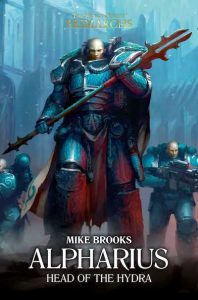 For the uninitiated, Alpharius is one of twenty demi-god like post-humans gene wrought by the Emperor of Mankind to re-take the stars about 28,000 years from now. While his nineteen brothers specialise in one form or another of brute force warfare, Alpharius and his Alpha Legion use the shadows to sow dissent and destabilise entire planets before the other primarchs and their legions arrive to bring the light (or death) of the Emperor to the lost arms of humanity.
For the uninitiated, Alpharius is one of twenty demi-god like post-humans gene wrought by the Emperor of Mankind to re-take the stars about 28,000 years from now. While his nineteen brothers specialise in one form or another of brute force warfare, Alpharius and his Alpha Legion use the shadows to sow dissent and destabilise entire planets before the other primarchs and their legions arrive to bring the light (or death) of the Emperor to the lost arms of humanity.
Depending on what books and fluff you’ve read, you’re either firmly in the “Alpha Legion are traitors” or the “Alpha Legion are the most brutally loyal of all the legions” camp, or like me, you just love skipping between the two depending on what you add to your body of knowledge about them. You’re never really sure, and this story doesn’t do a tremendous amount to solidify your opinion one way or another, but it does give you the story of how Alpharius was found and what his purpose was.
Brooks writes a pretty decent primarch—something I see as incredibly difficult to do as they are as a level of intellect above the post-human astartes as the astartes are to us mere humans. Their imagination, innovation, motivators, and such are somewhat removed from our own, but at a base level driven by the same foundational emotional stalwarts: loyalty, friendship, exclusion, jealousy, betrayal. In many of the primarchs, these things are thrown at you with the force of a thunder hammer, but with Alpharius’ blunt, pragmatic, and duplicitous point of view, you can never be sure, and I liked that.
With Alpharius: Head of the Hydra Brooks got most of the key things you want in a 40k novel right. Technology, action, the universe (with some lesser known factions popping up which is cool AF), but what didn’t land were the astartes that made up the Alpha legion. While in this book the legion is far more pragmatic than most, either by design or by accident, there is little bond between the astartes underneath Alpharius. There was little punch when they died in combat—they felt two dimensional and hard to invest in.
Alpharius: Head of the Hydra by Mike Brooks is an enjoyable and quick read, and breathes new life into an oft maligned and ignored character who I feel could be quite central and important to the continuation of the 40k universe now that the primarchs are returning as characters.
3.5/5
Read Alpharius: Head of the Hydra
The post REVIEW: Alpharius: Head of the Hydra appeared first on Grimdark Magazine.
May 9, 2021
MOVIE REVIEW: Mortal Kombat (2021)
MORTAL KOMBATTTTTTTT!
*techno music plays*
I am an absurdly huge fan of the Mortal Kombat universe, up to and including doing a book-long parody of the franchise in my Tournament of Supervillainy novel. I have loved the series from the original arcade games to the Mortal Kombat movies to the comic books and cheesy series. Most of them are quite bad but have a charm that makes you able to enjoy them anyway. Still, I was hesitant to watch this movie because remakes are always a dicey affair. Would it be better or worse than the original 1995 film? Well, it’s better than Annihilation but that’s a pretty low bar to clear.
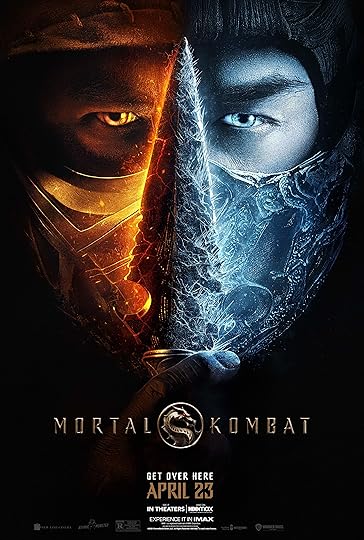 The premise is that Cole is a washed up MMA fighter doing fill-ins at a dingy gymnasium for $200 dollars a fight. Worse, he regularly loses and it is clear he’s not going to be moving any higher in the rankings. Hell, worse than that, it’s stated he used to be a champion but has aged out of his prime. Which, given Lewis Tan is 34 years old is believable enough. Cole was, however, born with a dragon-shaped birthmark that marks him as one of the Champions of Earthrealm. He is of an ancient lineage of heroes and is recruited by Jax and Sonya Blade to fight evil.
The premise is that Cole is a washed up MMA fighter doing fill-ins at a dingy gymnasium for $200 dollars a fight. Worse, he regularly loses and it is clear he’s not going to be moving any higher in the rankings. Hell, worse than that, it’s stated he used to be a champion but has aged out of his prime. Which, given Lewis Tan is 34 years old is believable enough. Cole was, however, born with a dragon-shaped birthmark that marks him as one of the Champions of Earthrealm. He is of an ancient lineage of heroes and is recruited by Jax and Sonya Blade to fight evil.
If this sounds a bit like someone’s Mortal Kombat fanfiction then you aren’t wrong. Cole is a weird stand-out in a franchise that already had many characters who were perfect to play one’s intro into the weird-weird world of magical death tournaments. Introducing a new one is unnecessary and distracts from the character development of the fan favorites that we came here to see. Liu Kang, Kung Lao, Sonya Blaze, Jax, Scorpion, and Raiden are all present on the side of “good” but barely figure into the story due to so much of it being devoted to Cole’s story arc. It’s doubly weird because Lewis Tan could easily have played a lot of the Mortal Kombat heroes.
Everyone else is there but not really able to do much or have much characterization. The good guys are just sort of blandly good and the bad guys are blandly evil. It honestly feels a bit like the old USA cartoon (yes, I remember that too). Liu Kang, Sonya, Jax, Kung Lao, and Raiden are all about teaching Cole to believe in himself so he can be the best hero he can be. Honestly, it made me confused because Cole isn’t Harry Potter. Hell, there’s already a Chosen One in the setting and it’s Liu Kang! Man, it would have been embarrassing if one of these other Champions of Earthrealm had won the tournament!
Speaking of the tournament, there’s not actually a tournament. This is another element of the movie that confuses me because it’s actually about Shang Tsung planning to assassinate all of the Mortal Kombat fighters before they can compete. Which means that they are very confident of a sequel and perhaps overly so. It doesn’t help that the Kombatants act like they’ve won the tournament even though, well, there wasn’t one.

There’s some decent elements to the story. The opening fifteen minutes are about the conflict between Scorpion and Sub-Zero that is actually quite good. It even remembers that Sub Zero is Chinese and Scorpion is Japanese, something that even a lot of Mortal Kombat junkies forget. We also have a lot of cartoonish violence that goes over the top like Kano ripping out the heart of an opponent. That was awesome. Speaking of Kano, he’s easily the best part of this movie and shows why a Johnny Cage-esque quipster is required.
In conclusion, Mortal Kombat (2021) is an okay movie. It’s not as good as the original but it’s not terrible. It reminds me of Resident Evil or Underworld in that it is best described as “brainless fun.” I may not enjoy watching Lewis Tan as much as Mila Jovavich or Kate Beckinsale but he’s a fantastic actor and martial artist stuck with a generic part. I probably wouldn’t have seen this in theaters but since it’s on HBO Max, it’s something I’m glad I watched.
The post MOVIE REVIEW: Mortal Kombat (2021) appeared first on Grimdark Magazine.
May 8, 2021
An Interview with Blake Howard
We here at Grimdark Magazine have done a lot of reviewing of Vampire: The Masquerade products since the release of Fifth Edition. We’ve especially been interested in the coverage of Vampire: The Masquerade: Winter’s Teeth by Tim Seeley, Tini Howard, and Blake Howard. It’s an intense urban fantasy comic book that serves as the perfect introduction to the World of Darkness for newcomers. It also is bound to please long-time fans of the seminal Nineties tabletop game that has been recently reintroduced to the public eye.
I’m very pleased to announce we’ve been able to get a short interview with Blake Howard, author of the Anarch Tales and RPG material of the comic book. As one of the principle architects of the work and biggest fans of the original game, he’s a guiding vision for what the comic has become. It’s good to get some insight into his process and I hope we’ll hear from him again.
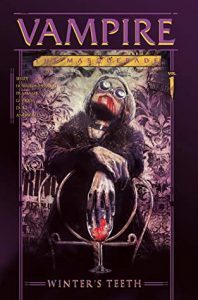 [GdM] Winter’s Teeth just released its first trade paperback. Congratulations. Could you describe for our readers the comic and what its about?
[GdM] Winter’s Teeth just released its first trade paperback. Congratulations. Could you describe for our readers the comic and what its about?
[BH] Winter’s Teeth is the first story arc in Vault Comics’ Vampire: the Masquerade comic series. It deals with the Twin Cities of Minneapolis and St. Paul and the vampires who dwell there. Volume 1 is a shared narrative about Cecily Bain, a Camarilla enforcer, and her adopted Caitiff childe named Ali. The B-Plot (of which I am a co-writer) is about a group of Anarchs and their struggles to get by, night-by-night.
[GdM] Were you familiar with the World of Darkness before you became involved?
[BH] Intimately so! I have been an avid player and storyteller since 2002.
[GdM] What is different about writing for a property like this versus other works you’ve worked on?
[BH] Obviously, when you are playing with someone else’s IP, there is an approval process for anything. In this case, we have been working with Paradox Interactive, who have been so incredibly supportive. We get notes back, from time to time, mostly about making sure that we are adhering to their vision of where they are taking The World of Darkness, but they are also willing to be flexible if we can justify any of our bolder story ideas.
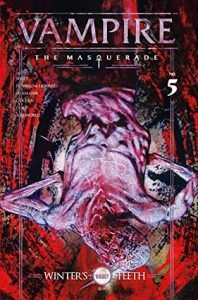 [GdM] Could you describe what you do for the comic?
[GdM] Could you describe what you do for the comic?
[BH] I am one-half of the writing team for the Anarch Tales storyline. I work with my wife, Tini Howard, who is a serious comic writing veteran. It would be fair to say that while I come up with the storyline, dialogue and characters, Tini is invaluable when it comes to making sure we are getting the right pacing, formatting, and other nuances that come from years of writing comic books.
[GdM] You’ve written a lot of RPG information for the Twin Cities in the back of the comic book. How would you describe it if Storytellers were to set a game there?
[BH] The cliché response is that it is a Tale of Two Cities. Minneapolis leans heavily Anarch while St. Paul is Camarilla-aligned. It is a microcosm of the U.S., in a lot of ways, where the Anarch territories meets the Ivory Tower of the East Coast and Midwest.
[GdM] How has fan reception been for it?
[BH] Overwhelmingly positive! It is a thrill to see people discuss and predict where we are going. We strove to tell a story that would resonate with long-time fans while also being accessible to new ones.
[GdM] What Clan would you be? Anarch or Camarilla (or Sabbat)?
Toreador, no contest. Prior to 5th edition, I maybe would have said Camarilla, but given the recent shake ups with the lore, probably Anarch.
[GdM] What can we expect for the second story arc of Winter’s Teeth?
[BH] Cecily will continue Ali’s education in the laws of the night, while the Anarchs (who have gone their separate ways) explore their own individual interests.
The post An Interview with Blake Howard appeared first on Grimdark Magazine.



